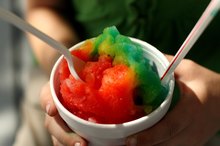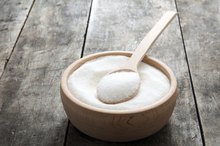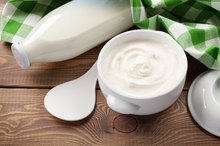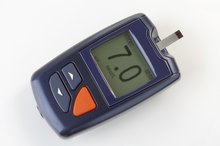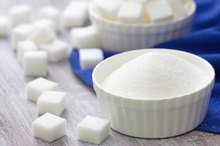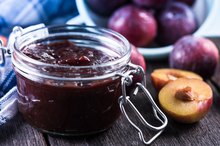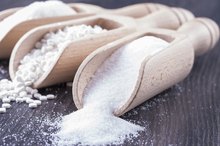What does fact checked mean?
At Healthfully, we strive to deliver objective content that is accurate and up-to-date. Our team periodically reviews articles in order to ensure content quality. The sources cited below consist of evidence from peer-reviewed journals, prominent medical organizations, academic associations, and government data.
- Mayo Clinic: High Fructose Corn Syrup: What Are the Health Concerns?
- Environmental Health: Mercury From Chlor-Alkali Plants: Measured Concentrations in Food Product Sugar
The information contained on this site is for informational purposes only, and should not be used as a substitute for the advice of a professional health care provider. Please check with the appropriate physician regarding health questions and concerns. Although we strive to deliver accurate and up-to-date information, no guarantee to that effect is made.
List of Foods Containing High Fructose Corn Syrup
High fructose corn syrup is a low-cost sweetener that replaced sugar in thousands of products over the past 30 years 2. In 1970, Americans consumed less than a pound of the syrup per year. In 2010, the average American consumed over 60 pounds per year, according to research from Princeton University. Manufacturers started reducing use of the product in the late 2000s because of concerns that it contains mercury and has led to record levels of obesity, according to The New York Times. Still, a check of many food labels shows the ingredient remains a staple.
Baked Goods
Many baked goods, including English muffins, rolls and white and whole wheat bread, contain high fructose corn syrup. The syrup helps baked goods achieve a brown crust and retain moisture.
Tomato-Based Sauces
Weight Watchers Points for Snow Cones
Learn More
Pizza sauce, spaghetti sauce, ketchup and barbecue sauces typically contain high fructose corn syrup, which is used to balance the tart tomatoes and bring out the flavors of herbs and spices.
Soft Drinks
Soft drinks use high amounts of the syrup as a source of intense sweetness. It also helps stabilize flavors over the long shelf-life of the drinks. Diet soft drinks do not usually contain the syrup.
Cereals
Side Effects of Polydextrose
Learn More
Some breakfast cereals, particularly sweetened ones, contain high fructose corn syrup 1. Cereals aimed at adults also often contain the syrup even if they don't taste especially sugary.
Fruit Drinks
Fruit drinks often contain high levels of the syrup. It is used in bottled juices, drink pouches and frozen concentrates. High fructose corn syrup has a lower freezing temperature than other sweeteners, and that makes thawing faster.
Processed Foods
Processed foods such as lunch meats, dinner sausage, macaroni and cheese, boxed meals, packaged lunch meals and other processed foods contain the syrup because:
- it is inexpensive
- provides a long shelf life
Salad Dressings
In an effort reduce calories from oil, many salad-dressing manufactures add high fructose corn syrup instead. Low-fat and low-calorie dressings tend to have higher levels of the syrup than dressings made with olive or another kind of oil.
Yogurt
Many yogurt brands contain the sweetener. Even flavors or yogurt lines that are called "all natural" and "organic" sometimes contain high fructose corn syrup.
Cough Syrups
Many liquid cough suppressants and expectorants contain high fructose corn syrup 1. Flavored varieties designed to taste better for children tend to have higher amounts of the sweetener.
Related Articles
References
- Mayo Clinic: High Fructose Corn Syrup: What Are the Health Concerns?
- Princeton University: A Sweet Problem -- Princeton Researchers Find That High-Fructose Corn Syrup Prompts Considerably More Weight Gain
- New York Times: "Sugar Is Back on Food Labels, This Time as a Selling Point"
- Environmental Health: Mercury From Chlor-Alkali Plants: Measured Concentrations in Food Product Sugar
- Popkin BM, Hawkes C. Sweetening of the global diet, particularly beverages: patterns, trends, and policy responses. Lancet Diabetes Endocrinol. 2015;4(2):174-186. doi:10.1016/S2213-8587(15)00419-2
- New Hampshire Department of Health and Human Services. How much sugar do you eat?. Updated August 2014.
- DeSilver D. How America's diet has changed over time. Pew Research Center. Updated December 13, 2016.
- Lakhan SE, Kirchgessner A. The emerging role of dietary fructose in obesity and cognitive decline. Nutr J. 2013;12:114. doi:10.1186/1475-2891-12-114
- Djiogue S, Nwabo Kamdje AH, Vecchio L, et al. Insulin resistance and cancer: the role of insulin and IGFs. Endocr Relat Cancer. 2013;20(1):R1-R17. doi:10.1530/ERC-12-0324
- Page KA, Chan O, Arora J, et al. Effects of fructose vs glucose on regional cerebral blood flow in brain regions involved with appetite and reward pathways. JAMA. 2013;309(1):63-70. doi:10.1001/jama.2012.116975
- Goran MI, Ulijaszek SJ, Ventura EE. High fructose corn syrup and diabetes prevalence: a global perspective. Glob Public Health. 2013;8(1):55-64. doi:10.1080/17441692.2012.736257
- Walker RW, Dumke KA, Goran MI. Fructose content in popular beverages made with and without high-fructose corn syrup. Nutrition. 2014;30(7-8):928-35. doi:10.1016/j.nut.2014.04.003
- American Heart Association. Added sugars. Updated April 17, 2018.
Writer Bio
Michelle Valenzuela is an award-winning journalist with experience since 1989. She has worked as an editor at the "Odessa (Texas) American," "The Fayetteville (N.C.) Observer" and the "News & Observer of Raleigh (N.C.)." Valenzuela earned a Bachelor of Arts in journalism from the University of Arizona.
